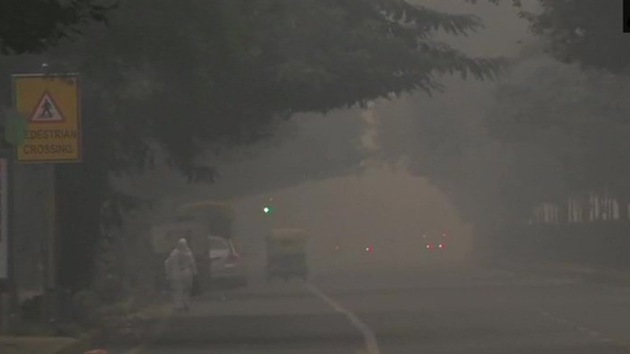Delhi’s air strays deeper into ‘severe’ zone, likely to dip to ‘severe+’ by Thursday
Scientists and weather experts said that low wind speed will continue to impact the national capital’s air quality till Thursday, with a possibility of the levels dipping further to reach ‘severe+’ category.
New Delhi: Air pollution levels in Delhi and adjoining areas were likely to enter the “severe plus” or “emergency” category on Wednesday, the government’s air quality monitor said a day after thick haze returned to the region after days of better air quality. Severe air pollution can worsen existing respiratory illnesses and also affect even healthy people.

System of Air Quality and Weather Forecasting and Research (SAFAR), the monitor, on Tuesday said that winds carrying plumes of smoke from stubble burning in Punjab and Haryana have led the spike in the pollution.
According to the Central Pollution Control Board (CPCB) data, Delhi’s average air quality index (AQI) was 457 at 6.40 am on Wednesday. News agency Press Trust of India (PTI) reported that the AQI in suburban Noida, Greater Noida, Faridabad and Gurugram was 472, 462, 441 and 448.
AQI between 201 and 300 is categorised as poor. The 301-400 range is considered very poor and 401-500 severe. The AQI above 500 falls under the severe plus category.
The official forecasters on Tuesday warned that the air quality could hit “emergency” levels over the next two days because of low surface wind and cloud cover. A dip in wind speed and temperatures worsens air quality by making air denser and trapping pollutants.
On Wednesday morning, Delhi recorded a minimum temperature of 14.2 degrees Celsius and at 81% humidity.
Also Watch | Thick smog engulfs NCR, air quality in ‘Hazardous’ category
“
Scientists and weather experts said that low wind speed will continue to impact the national capital’s air quality till Thursday. “The average wind speed on Tuesday remained around 7-8kmph. The situation will remain like this till Friday, after which winds are expected to pick up and clean the air a little,” said a scientist at the India Meteorological Department.
The CPCB-led Graded Response Action Plan task force was scheduled to have a meeting on Wednesday to assess pollution control measures in the city. The need to put into place additional dust control measures was expected be discussed at the meeting, according to the people aware of the developments.
The CPCB’s 4pm bulletin on the AQI on Tuesday showed the pollution was “severe” at 425 compared to 360 a day earlier. By 11pm on Tuesday, the AQI dipped to 449.
The Central Control Room for Air Quality Management on Tuesday reported that the 24-hour average concentration of PM2.5 ultra-fine particles in Delhi and the National Capital Region breached the 300µg/m3 level. The level is regarded as the threshold beyond which the pollution is considered to be in the emergency zone.
The spike in the pollution came as SAFAR on Tuesday said that the farm fire count had gone down and the wind pattern was bringing in airborne particles to the region.
It prompted the Delhi government to restrict outdoor activities in schools even as there were no immediate plans of shutting down educational institutes.
The extension of road rationing measures or the odd-even scheme to deal with the pollution was also due to be reviewed on Wednesday after an assessment of the air quality. The scheme was suspended for two days ahead of the 550th birth anniversary celebrations of Sikhism’s founder, Guru Nanak, on Tuesday.
As part of the scheme, the use of private cars has been restricted until November 15. The odd-even system allows cars on alternate days based on whether their licence plates end in odd or even number.
The AQI in Delhi hit the worst level—494—since 2016 on November 3. Three days later, the Supreme Court pulled up the Centre and the governments of Punjab, Haryana and Uttar Pradesh for failing to stop farm fires, which result in heavy concentrations of PM2.5 ultrafine particles in the air.
The smoke, vehicle exhaust, and construction dust contribute to Delhi air pollution and the particles can lead to major health problems as they can enter the bloodstream after penetrating deep into the lungs.
Pollution spikes are common in the first half of November in northern India as farm fires peak in Punjab and Haryana during this time and the resulting smoke settles over the region. Farmers often burn stubble left behind after harvest as a quick and cheap way of clearing their fields for the next round of sowing.
According to SAFAR, the share of stubble burning in Delhi’s air pollution on Tuesday was 25%. It was likely to reduce marginally on Wednesday to 22%.



